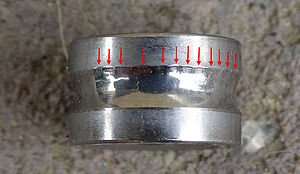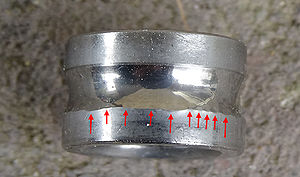Overload: Difference between revisions
(Created page with "Overload (Also known as Overload Deformation, Brinelling, and True Brinelling) is where a bearing's raceways get permanent indentations at the ball pitch as a...") |
mNo edit summary |
||
| (5 intermediate revisions by the same user not shown) | |||
| Line 1: | Line 1: | ||
[[Overload]] (Also known as Overload Deformation, Brinelling, and True Brinelling) is where a bearing's [[Raceway|raceways]] get permanent indentations at the ball pitch as a result of exceeding the static load limit of the raceway material. The indentations match the ball shape and are usually surrounded by a build-up formed by displaced material. | [[Overload]] (Also known as Overload Deformation, Brinelling, and True Brinelling) is where a bearing's [[Raceway|raceways]] get permanent indentations at the ball pitch as a result of exceeding the static load limit of the raceway material. The indentations match the ball shape and are usually surrounded by a build-up formed by displaced material. | ||
Freestyle skateboarding, by its very nature, does not limit itself to just rolling, so when we do [[:Category:Rail Tricks|Rail Tricks]], we are applying [[Axial|axial]] forces as well. The static overloading and shock loads from [[:Category:Rail Tricks|rail tricks]] tend to cause overload deformation because it can easily exceed the [[Axial|axial]] load limit of bearings that were really only designed to withstand [[Radial|radial]] forces. | Freestyle skateboarding, by its very nature, does not limit itself to just rolling, so when we do [[:Category:Rail Tricks|Rail Tricks]], we are applying [[Axial|axial]] forces as well. The static overloading and shock loads from [[:Category:Rail Tricks|rail tricks]] tend to cause overload deformation because it can easily exceed the [[Axial|axial]] load limit of bearings that were really only designed to withstand [[Radial|radial]] forces. Bearings with deep races, however, can be much more durable in this respect. | ||
<div><ul> | <div><ul> | ||
<li style="display: inline-block;"> [[File:Overload Indentations on Inner Raceway of Mini-Logo Bearing 1.jpg|thumb|none|Overload indentations on the inner raceway of a Mini-Logo bearing. freestylekb.com ]]</li> | <li style="display: inline-block;"> [[File:Overload Indentations on Inner Raceway of Mini-Logo Bearing 1.jpg|thumb|none|Overload indentations on the inner raceway of a Mini-Logo bearing from many hours worth of rail tricks. freestylekb.com ]]</li> | ||
<li style="display: inline-block;"> [[File:Overload Indentations on Inner Raceway of Mini-Logo Bearing 2.jpg|thumb|none| | <li style="display: inline-block;"> [[File:Overload Indentations on Inner Raceway of Mini-Logo Bearing 2.jpg|thumb|none|More overload indentations on the inner raceway of a Mini-Logo bearing from many hours worth of rail tricks. freestylekb.com ]]</li> | ||
</ul></div> | </ul></div> | ||
The [[ISO]] classification for this failure mode can be found in [ | The [[ISO]] classification for this failure mode can be found in [https://www.iso.org/standard/59619.html ISO 15243:2017 (Rolling bearings -- Damage and failures -- Terms, characteristics and causes)] (Formerly [http://www.iso.org/iso/catalogue_detail.htm?csnumber=27042 ISO 15243:2004]), 5.5 Plastic deformation -> 5.5.2 Overload deformation. | ||
[[File:Overload Indentations on Raceway at Ball Pitch - SKF.jpg|thumb|none|Another example of indentations on the raceway at ball pitch. skf.com ]] | |||
[[Category:Glossary]] | |||
Latest revision as of 02:48, 22 April 2018
Overload (Also known as Overload Deformation, Brinelling, and True Brinelling) is where a bearing's raceways get permanent indentations at the ball pitch as a result of exceeding the static load limit of the raceway material. The indentations match the ball shape and are usually surrounded by a build-up formed by displaced material.
Freestyle skateboarding, by its very nature, does not limit itself to just rolling, so when we do Rail Tricks, we are applying axial forces as well. The static overloading and shock loads from rail tricks tend to cause overload deformation because it can easily exceed the axial load limit of bearings that were really only designed to withstand radial forces. Bearings with deep races, however, can be much more durable in this respect.
The ISO classification for this failure mode can be found in ISO 15243:2017 (Rolling bearings -- Damage and failures -- Terms, characteristics and causes) (Formerly ISO 15243:2004), 5.5 Plastic deformation -> 5.5.2 Overload deformation.


